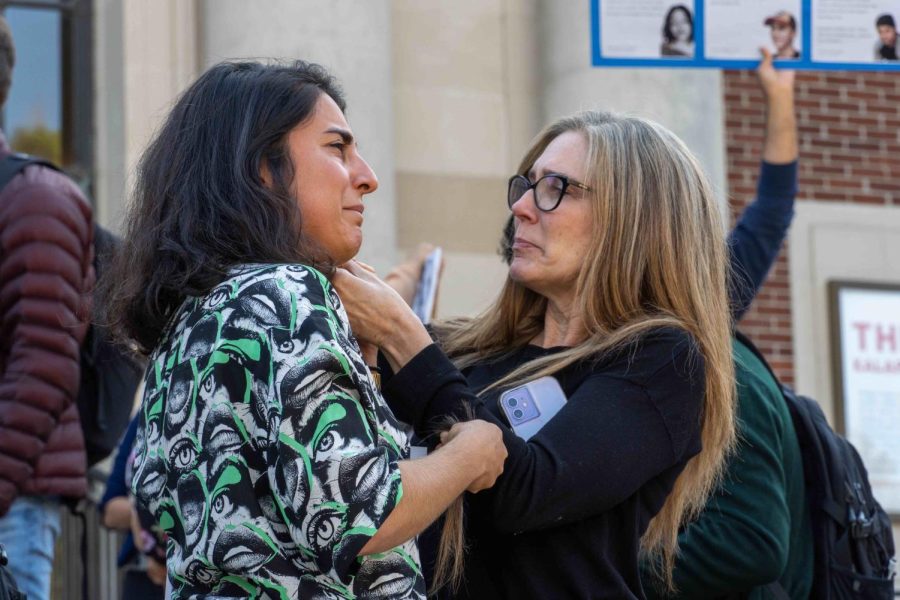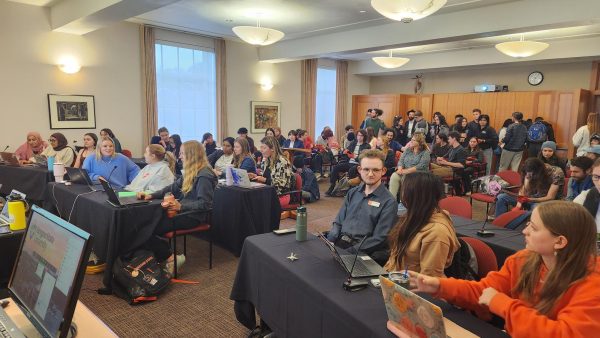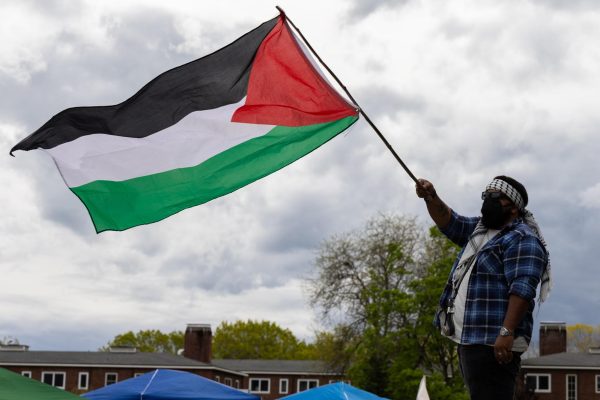Iran protest held in MU Quad amidst deconstruction of Believe It campaign
Two protestors cut their hair in front of the Memorial Union on Oregon State University campus on Monday. Cutting hair has been used as a statement against oppression during the protests against the Iranian government.
October 18, 2022
Oregon State University’s Memorial Union Quad was home to two very different activities Monday afternoon.
While construction workers were busy tearing down the temporary building used to celebrate the over $1 billion raised for various OSU interests, students and Corvallis residents gathered on the opposite side of the quad to protest the Islamic Republic in Iran.
Multiple students and OSU staff shared their voices amongst other parts of the protest. This included a two minute and 22 second long moment of silence for Mahsa Amini, who was allegedly killed by Iran’s ‘Morality Police’ at just 22 years old in September.
The sounds of construction continued in the background during the moment of silence for the Iranian woman, who died for failure to properly wear her hijab. Amini is now one of thousands who have been killed by the Islamic Republic.
“I am not even able right now to talk to my parents, you know, the internet is shut down,” said OSU student and Iranian, Arman Askarizadeh. “The VPN is not working; there is no sort of connection at all for me even to even know that they’re safe.”
Askarizadeh was one of the main speakers at the protest, and he considered his participation in the event the least he could do.
“When you want a revolution, it cannot just be done by people back home,” Askarizadeh said. “We are living in a war where we need more support.”
For Askarizadeh, who came to the U.S. at the age of 17, he said he found the freedom available here to be a culture shock. A fraction of that freedom is something that Askarizadeh wishes he could bring to people back home.
“I know that 20% [of America’s freedom] can make a huge difference in their lives. Just my mom, being able to go outside and present herself the way she wants to, that can take away a lot of burden in her life,” Askarizadeh said.
Not alone in wanting to bring freedom to Iran, Askarizadeh protested alongside over 20 people including OSU graduate, Alaura Samadi. Samadi, who herself is white, is married to an Iranian man who was also present at the protest.
“As a wife of someone going through it, I’m so torn,” Samadi said. “I wish I could just have him stop watching all the sad stuff on the news. But how could he not watch it?”
According to Samadi, she believes there is a lack of awareness for a lot of people just because there has been a lack of news coverage. To Samadi, she wants more people in general to show up to these protests, people of any background, because she wants awareness to spread.
“It’s (been) more than a month with plenty of atrocities happening, that we would never allow our government to do,” Samadi said. “Their government is literally silencing people by arresting them for creating art, or murdering them for barely showing hair.”
For Samadi, she supported the message of the protest to write to local legislators — especially senators — because there are people out there who are lobbying for the opposite side.
“We have to be their voice. And that’s why I’m here,” Samadi said. “That’s why I want to continue doing that, and it’s just sad that the voice isn’t louder yet.”
To support the Iranian protest there is a petition on change.org that protestors encouraged attendees to sign.
For information on who you US Senate Representative is, the Senate provides that information at the following link: https://www.senate.gov/senators/senators-contact.htm

























































































































